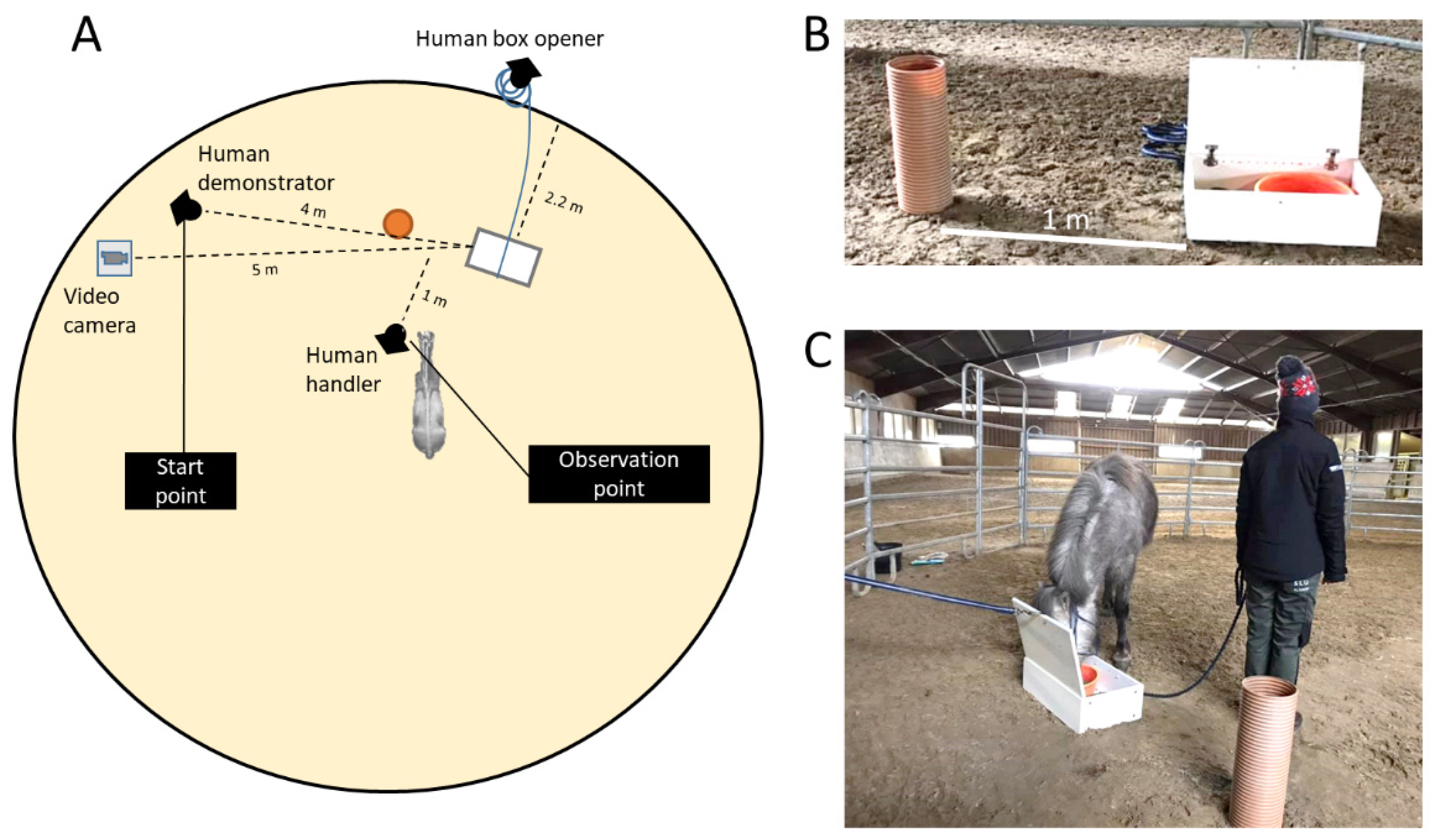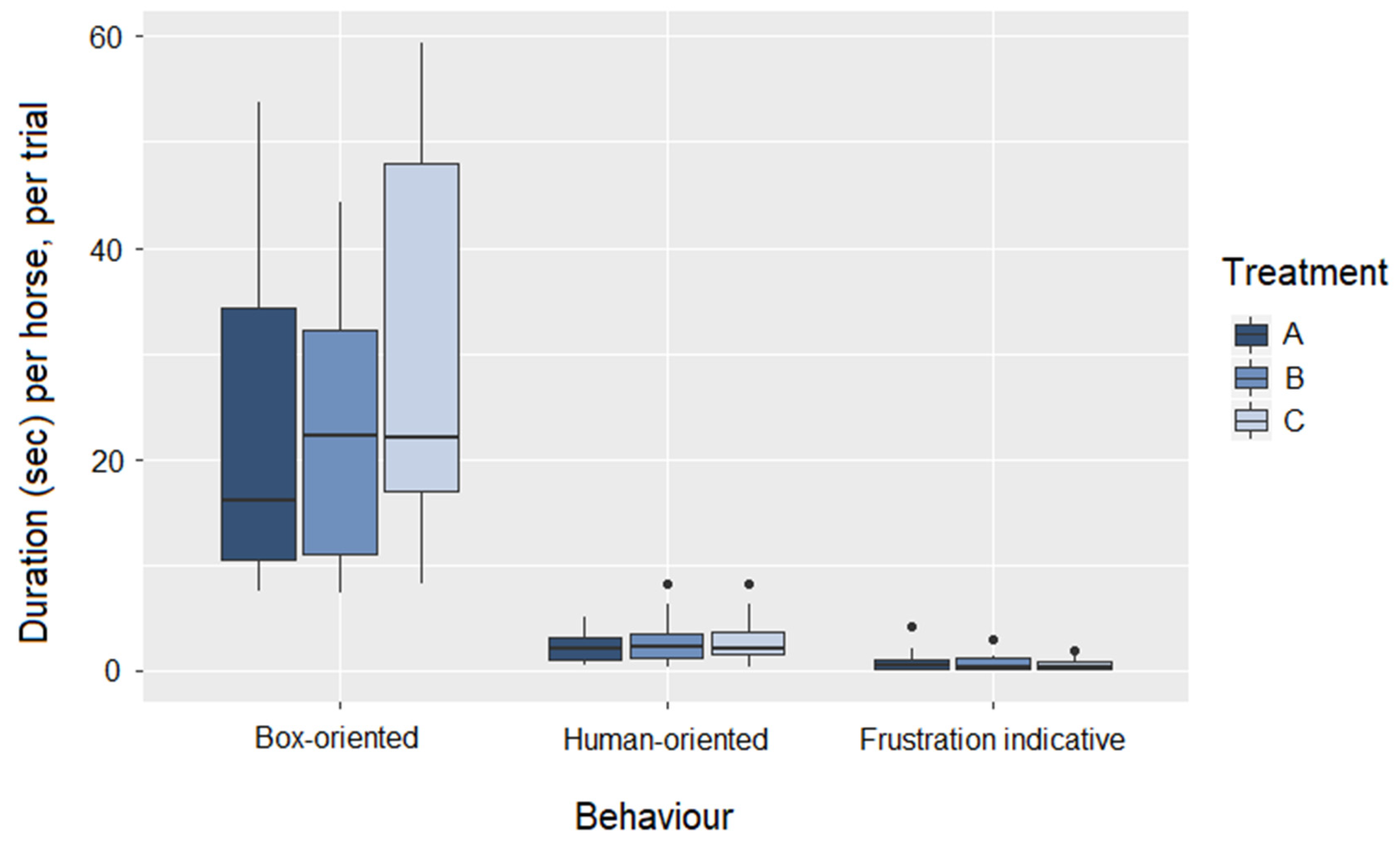Horses Failed to Learn from Humans by Observation
Abstract
Simple Summary
Abstract
1. Introduction
“In no case is an animal activity to be interpreted in terms of higher psychological processes if it can be fairly interpreted in terms of processes which stand lower in the scale of psychological evolution and development” [6].
- (1)
- more horses from treatment group A and B would solve the task than from group C, if the horses rely on social transmission mechanisms (A = B > C), or that
- (2)
- more horses from treatment group A than from B, and more horses from group B than C would solve the task, if the horses utilize actual social learning (A > B > C).
2. Materials and Methods
2.1. Experimental Venue and Animals
2.2. Experimental Design and Device
2.3. Experimental Procedure and Treatments
2.4. Habituation
2.5. Experimental Procedure
2.6. Behavioral Observations
2.7. Statistical Analyses
2.8. Ethical Statement
3. Results
3.1. Learning Criterion and Effect of Treatments
3.2. Box-Oriented Behaviour
3.3. Human-Oriented Behaviour
3.4. Frustration Indicative Behaviour (Behavior not Related to the Task)
4. Discussion
- (1)
- more horses from treatment group A and B would solve the task than from group C, if the horses rely on social transmission mechanisms (A = B > C), or that
- (2)
- more horses from treatment group A than from B, and more horses from group B than C would solve the task, if the horses utilize actual social learning (A > B > C).
5. Conclusions
Supplementary Materials
Author Contributions
Funding
Acknowledgments
Conflicts of Interest
References
- Thorpe, W.H. Learning and Instinct in Animals; Methuen: London, UK, 1963; p. 55. [Google Scholar]
- Heyes, C. What’s social about social learning? J. Comp. Psychol. 2012, 126, 193. [Google Scholar] [CrossRef] [PubMed]
- Galef, B.G. Imitation and local enhancement: Detrimental effects of consensus definitions on analyses of social learning in animals. Behav. Processes 2013, 100, 123–130. [Google Scholar] [CrossRef] [PubMed]
- Rørvang, M.V.; Christensen, J.W.; Ladewig, J.; McLean, A. Social Learning in Horses—Fact or Fiction? Front. Vet. Sci. 2018, 5, 212. [Google Scholar] [CrossRef] [PubMed]
- Boesch, C.; Tomasello, M. Chimpanzee and Human Cultures. Curr. Anthropol. 1998, 39, 591–614. [Google Scholar] [CrossRef]
- Morgan, C.L. Other minds than ours. In An Introduction to Comparative Psychology; Morgan, C.L., Ed.; Walter Scott: London, UK, 1903; p. 59. [Google Scholar]
- Avarguès-Weber, A.; Dawson, E.H.; Chittka, L. Mechanisms of social learning across species boundaries. J. Zool. 2013, 290, 1–11. [Google Scholar] [CrossRef]
- Burla, J.B.; Siegwart, J.; Nawroth, C. Human demonstration does not facilitate the performance of horses (Equus caballus) in a spatial problem-solving task. Animals 2018, 8, 96. [Google Scholar] [CrossRef]
- Henriksson, J.; Sauveroche, M.; Roth, L.S.V. Effects of size and personality on social learning and human-directed behaviour in horses (Equus caballus). Anim. Cogn. 2019, 22, 1001–1011. [Google Scholar] [CrossRef] [PubMed]
- Schuetz, A.; Farmer, K.; Krueger, K. Social learning across species: Horses (Equus caballus) learn from humans by observation. Anim. Cogn. 2017, 20, 567–573. [Google Scholar] [CrossRef] [PubMed]
- Bernauer, K.; Kollross, H.; Schuetz, A.; Farmer, K.; Krueger, K. How do horses (Equus caballus) learn from observing human action? Anim. Cogn. 2019, 23, 1–9. [Google Scholar] [CrossRef]
- McGreevy, P.; Christensen, J.W.; Von Borstel, U.K.; McLean, A. Equitation Science, 2nd ed.; Wiley Blackwell: Oxford, UK, 2018; ISBN 9781119241416. [Google Scholar]
- Rochais, C.; Henry, S.; Hausberger, M. “Hay-bags” and “Slow feeders”: Testing their impact on horse behaviour and welfare. Appl. Anim. Behav. Sci. 2018, 198, 52–59. [Google Scholar] [CrossRef]
- The R Foundation for Statistical Computing R Core Team. 2019. Available online: https://www.r-project.org/ (accessed on 9 May 2019).
- Wickham, H. ggplot2: Elegant Graphics for Data Analysis; Springer-Verlag: New York, NY, USA, 2009. [Google Scholar]
- SJVFS Saknr L 150: Statens jordbruksverkets föreskrifter och allmänna råd om försöksdjur; Jönkjöping, Sweden. 2019. Available online: http://www.jordbruksverket.se/download/18.7c1e1fce169bee5214fad877/1553851490782/2019-009.pdf (accessed on 10 July 2019).
- Kilkenny, C.; Browne, W.J.; Cuthill, I.C.; Emerson, M.; Altman, D.G. Improving bioscience research reporting: The ARRIVE guidelines for reporting animal research. PLoS Biol. 2010, 8, e1000412. [Google Scholar] [CrossRef] [PubMed]
- Duncan, I.; Hagan, K.; Jose Hotzel, M.; Lay, D.; Olsson, A.; Sherwin, C.; Whittaker, A.; Martin, F. Ethical Treatment of Animals in Applied Animal Behaviour Research: Ethical Stand-Point & Decision Models. Int. Soc. Appl. Ethol. 2013. Available online: https://www.applied-ethology.org/res/EthicalGuidelinesISAErevised2017%20for%20council%20meeting.pdf (accessed on 10 July 2019).
- Lindberg, A.C.; Kelland, A.; Nicol, C.J. Effects of observational learning on acquisition of an operant response in horses. Appl. Anim. Behav. Sci. 1999, 61, 187–199. [Google Scholar] [CrossRef]
- Ahrendt, L.P.; Christensen, J.W.; Ladewig, J. The ability of horses to learn an instrumental task through social observation. Appl. Anim. Behav. Sci. 2012, 139, 105–113. [Google Scholar] [CrossRef]
- Sankey, C.; Henry, S.; André, N.; Richard-Yris, M.A.; Hausberger, M. Do horses have a concept of person? PLoS ONE 2011, 6, e18331. [Google Scholar] [CrossRef] [PubMed]
- Lesimple, C.; Sankey, C.; Richard, M.A.; Hausberger, M. Do horses expect humans to solve their problems? Front. Psychol. 2012, 3, 306. [Google Scholar] [CrossRef] [PubMed]
- Proops, L.; McComb, K. Attributing attention: The use of human-given cues by domestic horses (Equus caballus). Anim. Cogn. 2010, 13, 197–205. [Google Scholar] [CrossRef] [PubMed]
- Krueger, K.; Flauger, B.; Farmer, K.; Maros, K. Horses (Equus caballus) use human local enhancement cues and adjust to human attention. Anim. Cogn. 2011, 14, 187–201. [Google Scholar] [CrossRef] [PubMed]
- Proops, L.; Walton, M.; McComb, K. The use of human-given cues by domestic horses, Equus caballus, during an object choice task. Anim. Behav. 2010, 79, 1205–1209. [Google Scholar] [CrossRef]



| Treatment Group A | Treatment Group B | Treatment Group C | |
|---|---|---|---|
| Stallions | 1 | 2 | 1 |
| Geldings | 1 | 2 | 2 |
| Mares | 8 | 6 | 7 |
| Age (median (range)) | 5 (4–7) | 6 (5–10) | 5 (5–18) |
| Treatment | Ntotal | No. Successful Horses | Trials to 1st Success | Trials to Accomplish Learning Criterion for Successful Horses |
|---|---|---|---|---|
| A (Full demo) | 10 | 6 | 2 (2;4.8) | 13.5 (11.5;14.8) |
| B (Partial demo) | 10 | 6 | 4 (3;6) | 15.5 (13;21) |
| C (No demo) | 10 | 4 | 5.5 (3.5;9) | 15.5 (13;18.8) |
| Treatment | Pushing Box | Sniffing Box | Licking Box | Biting Box | Kicking Box | Total Box-Oriented |
|---|---|---|---|---|---|---|
| A | 1.0 (0.0; 12.5) | 105 (73.5; 137.5) | 68.0 (32.0; 188.0) | 3.0 (0.0; 6.0) | 2.5 (1.0; 4.8) | 16.2 (10.4; 34.4) |
| B | 1.0 (0.0; 1.0) | 90.0 (72.8; 147.0) | 188.0 (75.0; 272.0) | 7.0 (0.5; 14.0) | 1.0 (1.0; 3.5) | 22.2 (11.0; 32.2) |
| C | 0.0 (0.0; 1.0) | 106.5 (84.5; 175.5) | 164.0 (74.0; 294.0) | 4.0 (0.0; 11.0) | 2.5 (2.0; 3.0) | 22.2 (17.0; 48.0) |
© 2020 by the authors. Licensee MDPI, Basel, Switzerland. This article is an open access article distributed under the terms and conditions of the Creative Commons Attribution (CC BY) license (http://creativecommons.org/licenses/by/4.0/).
Share and Cite
Rørvang, M.V.; Nielsen, T.B.; Christensen, J.W. Horses Failed to Learn from Humans by Observation. Animals 2020, 10, 221. https://doi.org/10.3390/ani10020221
Rørvang MV, Nielsen TB, Christensen JW. Horses Failed to Learn from Humans by Observation. Animals. 2020; 10(2):221. https://doi.org/10.3390/ani10020221
Chicago/Turabian StyleRørvang, Maria Vilain, Tina Bach Nielsen, and Janne Winther Christensen. 2020. "Horses Failed to Learn from Humans by Observation" Animals 10, no. 2: 221. https://doi.org/10.3390/ani10020221
APA StyleRørvang, M. V., Nielsen, T. B., & Christensen, J. W. (2020). Horses Failed to Learn from Humans by Observation. Animals, 10(2), 221. https://doi.org/10.3390/ani10020221





